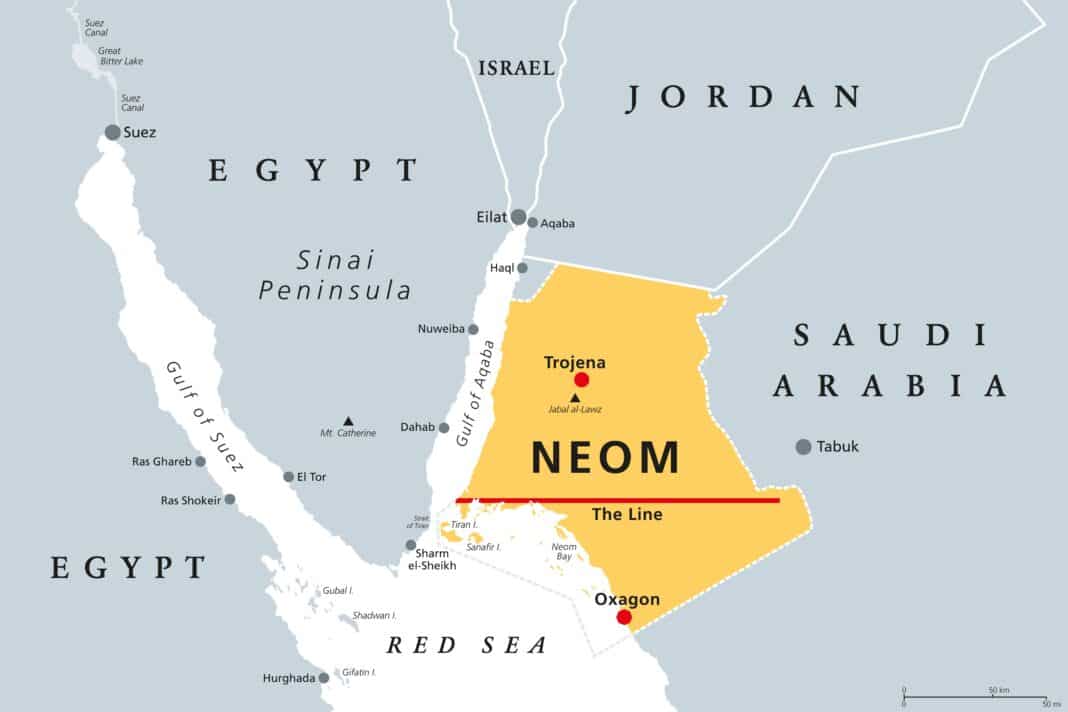The world’s largest construction project is now using more than 20% of global steel production (and a lot of timber, too) and will continue to use massive amounts for decades to come – with the surge coming as the European Union faces a 16 million-tonne-a-year shortage of steel and steel producers battle to lower emissions to reach climate targets.
Manar Al Moneef, the Chief Investment Officer for the Neom Gigacity, who spoke at the Global Logistics Forum in Riyadh, Saudi Arabia, earlier this month, said, “Neom will be the largest customer (in logistics) over the next decade. If you look at the demand for logistics, it’s 5% of the global logistics market.”
“We are (also) 20% of the global steel market. If you look at our demand in elevators, cement and so on…put simply, Neom will be the largest customer over the next few decades.”
Manar Al Moneef, the Chief Investment Office for the $500 billion Neom Gigacity
Speaking to Newsweek, Dr Andrzej Kotas, publisher of the industry publication Steel On The Net, said the volume of materials required to deliver on Mohammed Bin Salmon’s vision to connect 26,000 km² of land to the Red Sea, an area larger than Israel and Kuwait, will require a “colossal amount” of steel.
“I can’t think of any projects that come anywhere near that,” Mr Kotas said. “You have some very large transnational oil and gas pipelines, but nothing that comes close to 20% of the world’s consumption.”
“Put simply, it leaves anything else absolutely way behind, really.”
Is the reliance on few major steel producers a risk to global supply chains?
As it stands, China (responsible for producing 67.4 million metric tonnes of steel) and India (which produces 12.1 million metric tonnes of steel) dominate the global steel markets, with Japan, the United States, and Russia rounding out the top five. This makes global steel, like timber, one of the industries with the heaviest reliance on international trade.

During Covid, curbs on steel production and bottlenecks across the global shipping networks drove up material prices, which in turn caused construction projects to slow to a crawl, leaving steel-hungry economies (like Australia) vulnerable to the squeeze:
“Combined with rising sea freight, there (was) a huge increase in steel prices coming into the Australian economy,” according to David Buchanan, CEO of the Australian Steel Association, who spoke to the Australian Financial Review at the height of the pandemic in 2021.
According to the International Energy Agency, an intergovernmental organisation set up by the Organisation for Economic Co-operation and Development (OECD), emissions have surged in China and India (which has now surpassed the EU to become the third largest emitter) as both countries make up for lost time from the pandemic.
A report published by the Global Energy Monitor (GEM) last year showed that the steel industry was making ground in its bid to decarbonise but was nonetheless falling short of what is needed to keep global warming below 1.5 degrees. This requires more than half (53%) of all steelmaking to use electric arc furnace (EAF) technology instead of coal-based blast furnace-basic oxygen furnaces (BF-BOF) by 2050.
Published last September, the UN Environmental Programme partnered with the Yale Centre for Ecosystems and Architecture to produce a new construction blueprint to drive net-zero emissions. The blueprint calls on global construction to substitute carbon-intensive building materials, like steel and concrete, for bio-based materials like timber, bamboo, and biomass, saving up to 40% of emissions by 2050.
It has also raised concerns about processing concrete, steel, and aluminium, “three sectors responsible for 23% of global emissions. Priorities should be placed on electrifying production with renewable energy sources, increasing the use of reused and recycled materials, and scaling innovative technologies.”
- To learn more about the Neom project, which is now using engineered wood products to build its construction executive suites, click here for Wood Central’s special feature.






